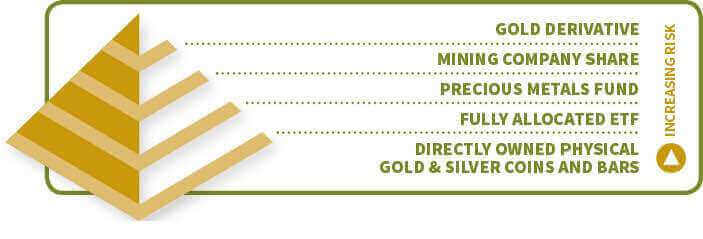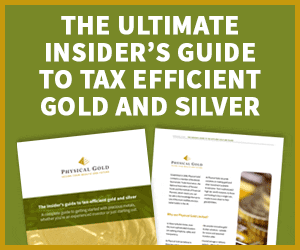Blog
Physical Gold versus Gold ETF
Accessing Gold & Silver
It’s not what you do, it’s the way that you do it! It’s possible to gain exposure to gold and silver in many ways, but the outcome may be completely different from one to another. The most common ways to get involved with gold investment are;
By purchasing physical bullion, buying shares in an exchange traded fund (Gold ETF), a traditional fund or mining company, or riskier option such as spread betting, futures or contracts for difference (CFD).
Gold ETF, fund or Physical Gold. Which option is best for me?
Each option of exposure to precious metals has its merits. The right choice will depend on your individual objectives. For example, if you have a high appetite for risk, then you may fancy your luck investing in a mining company. Alternatively, if you’re looking to actively trade the market, then electronic options such as ETFs will be the most efficient way to achieve the short-term speculation.
Risk
However, the most powerful benefit offered by gold and silver, is balance and protection. As well as professional traders, regular, everyday people buy gold and silver to REDUCE their overall risk.
Electronic and paper options provide investors with exposure to the market, but they also present additional risks. This undermines the value of gold & silver as a crisis hedge, or as portfolio insurance in the first place. Investment experience should also play a role in deciding which type of gold investment to opt for. Certainly derivatives should be left well alone by most people as they’re far more suitable for experienced investors. If the market moves against you, the amount you lose isn’t just limited to your original investment due to leverage.
Thinking of gold investment? Download the crucial 7 steps cheat sheet first
Similarly, if you’re tempted to invest into a gold mining company, far more research is required. Not only do you need to understand the gold market itself, but also you’ll need to examine into the underlying mining company, it’s structure and the ability of its management. Selecting a gold fund reduces the risk of depending on one company’s performance. However, you’re still investing into mining companies rather than gold itself. At the end of the day, you only actually own a piece of paper. Your exposure is not only to the underlying compaies within the fund, but also to the manager’s of the fund itself.
A Gold ETF can be a better way of gaining exposure to gold itself, but it too represents certain risks. The fund may be leveraged, so that the amound invested into the ETF isn’t necessarily backed up by the euqivalent amount in gold bullion. This means that if sufficient holders of the gold ETF wished to sell their holding simultaneously, there possibly won’t be enough physical gold to satisfy all those sales.
Costs and tax efficiency
Undoubtedly, if your buying cost is your main focus, then ETFs and funds are the cheapest ways to buy gold or gold related companies. The cost of manufacturing gold coins and bars is more expensive than simply buying something electronically. However there are other costs to consider. Funds generally have ongoing managment fees to pay. Physical Godl needs to be stored which costs money, although an increasing number of investors are taking personal possessio of their coins and bars to storage cheaply at home.
A major factor commonly overlooked is tax efficiency. Investment grade gold is VAT-exempt and certain coins are Capital Gains Tax free making ownership fully tax efficient. For the few percent extra you pay when buying, you may well be saving up to 28% later when you sell at a profit.
Physical gold and silver coins are by far the safest way of providing long-term stability. It’s also the most suitable way of passing welath down the generations. Trust me, kids prefer to receive something tangible with real value than a piece of paper promising worth. They present the most secure method of protecting your family’s wealth in a tax efficient way.






Pingback: Benefits Of Gold Investment [Guide & Infographic] | Physical Gold Limited
Making the right choice depends on an investor’s objectives and risk appetite. Mining shares represent higher risk, higher possible return